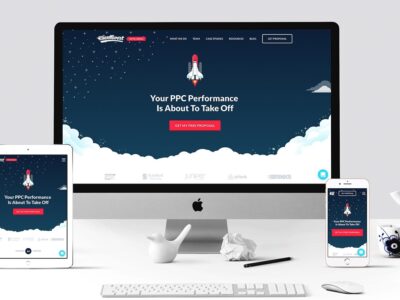Website Optimization: A good company website alone is not enough to generate a lot of traffic and acquire new customers. If the page is confusing, the content is insufficient, or the infrastructure is technically outdated, the website ends up at the bottom of the Google search and goes under.
We’ll show you how to optimize your website, what is important when optimizing a website and what role search engine optimization plays in this – let’s go!
Why Optimize Your Website?
In 2020 alone, online sales in the United States rose by 14.6%. Taking advantage according to statistics, 51 percent of online shoppers for their research Google. Even when searching locally for a doctor or a restaurant, people often trust the search engine (for example, 7 out of 10 searches for a doctor start on Google).
For general questions, be it recipes or instructions, Google has long since replaced human advice.
Since 86 percent of users only look at the results on the first page, the Google ranking is of central importance. For this reason alone, it is worth optimizing your website for the search engine and generating more target group-relevant traffic.
Possible goals of website optimization summarized:
- More Organic Website Traffic
- More Completed Goals (e.g. Purchases, Newsletter Registrations Or Lead Magnet Downloads)
- Improved User Signals (longer Dwell Time, Lower Bounce Rate, Etc.)
- Optimized Conversion Rate
- Increased Awareness
Optimize Your Website Yourself Or Have It Optimized?
For example, if you run a website as a self-employed person or practice, you can optimize it yourself with a few tips. In the following sections, we will show you how to improve your ranking with skilful content management, the right navigation structure and better technical parameters.
However, as a large company with a large website, there are many aspects that you need to consider when optimizing your website to get more leads.
It is difficult for laypeople to keep track. For this reason, we recommend hiring an expert. Since a visible and optimized website means more relevant traffic and a higher conversion rate, the investment is usually worthwhile after a short time.
How To Optimize Your Website Yourself
If your financial resources are limited, you can do a lot on your own. Optimizing the content (texts and images), the navigation structure and the meta-data already produces noticeable results. If you also improve the structure and thus the user experience in the long term, Google will reward you with a better search engine ranking.
Optimize Website Texts (content)
Not only people but also search engines distinguish valuable content from meaningless texts. Correctly placed keywords with a high search volume and easily legible texts play a major role for Google. At the same time, lively, up-to-date content attracts readers.
Numerous content marketing tools help with the research and planning of content. The free “ Answer the Public ” shows, for example, the most frequent Internet queries for a specific keyword. Chargeable ones such as Buzzsumo or Sistrix indicate, among other things, which articles on a particular term are most shared on social networks.
Optimize Website Structure
Just as a building must have a clear floor plan, your website should also have a logical structure. With the silo method, you divide your sub-pages into topic clusters, which can have several levels.
You should prevent:
- Nested Web Pages With More Than Four Levels.
- Internal Links That Criss-cross Through The Various Silos Without Any Reference To Content.
If your website contains images, you should ensure that they are of good quality. Pixelated, amateurish photos also make the entire website look amateurish. It doesn’t always have to be a professional photographer. Websites like Pixabay or Pexels offer high-quality images that are free of copyrights.
Beyond looks, here are some tips to keep in mind:
- Give the pictures a meaningful name (not pic_1345937) that contains the main keyword.
- The search engine crawler cannot rate images per se but reads the alt tag. For this reason, it should contain a meaningful description.
- Images that are too large increase the loading time. Make sure that your pictures are no more than 100 kilobytes in size.
Optimize Navigation (menu)
The most exciting content is of little use if visitors can’t find it. A user-friendly navigation menu is clear and contains meaningful terms (for example, “About us”, “History”, “Contact”, “Blog”). In addition, it is important to group the sub-items into meaningful categories.
If you are optimizing your menu, the following rules will help:
- The main menu should be clearly visible, preferably at the top, and extend horizontally.
- Drop-down menus with too many sub-menus “overwhelm” website visitors.
- Do not create more than seven main menu items.
Optimize Conversion And Call To Action

Many visitors don’t necessarily mean lots of sales, lots of clicks, or lots of subscribers. According to statistics from 2020, the average conversion rate for e-commerce websites is around 2.5 percent.
However, successful homepages reach up to 5 percent and more, and the rate also varies depending on the conversion goal (click, registration, download).
If your conversion rate stagnates despite high visitor numbers, you should:
- Make The Call To Action Clearer And More Concise
- Avoid Unnecessary Buttons And Interactive Elements That Distract Attention
- Rely On A Uniform Design
Tip From Tech Meets Tech
Furthermore, there is no magic formula to increase the conversion rate. But if you improve the technical SEO parameters, make the content exciting and optimize it for the target group, you have a good chance of getting more deals.
Optimize Meta Title And Meta Description
The meta title and meta description appear first in the SERPs and are the first to be perceived by the search engine’s crawler. For this reason, it is worthwhile to optimize it as follows:
- Note the maximum permitted pixel length; otherwise, Google will cut off the texts.
- Make sure that both the meta title and the meta description contain the main keyword.
- Choose a meaningful and interesting text according to the AIDA principle (Attention-Interest-Desire-Handling) to attract potential visitors to your site.
With the SERP Snippet Generator, Sistrix evaluates the quality of your metadata. You can also create a new snippet and have it checked.
Optimize On-page SEO
On-page SEO is understood to mean all measures that directly affect the website and increase its visibility on the Internet. In addition to the already mentioned optimization of metadata, images and content, the following parameters also play a role:
- Short loading times
- Mobile optimization
- A meaningful URL structure with speaking URLs
- A clean code
Free Tools To Optimize The Website
Not every website operator has a large budget for paid optimization tools. But even as a self-employed person or a practice owner, you can optimize many important aspects of your website with free tools. Google alone offers two options the Search Console and Analytics.
Google Search Console
One of the most powerful tools is undoubtedly Google Search Console (formerly Webmaster). The offer is aimed at web developers and private and commercial website operators who technically want to optimize their home page.
Among other things, the Search Console can do the following:
- Show errors in the code, in the links or the sitemap (e.g. 404 errors, format errors in the metadata, etc.)
- List search terms that visitors use to find your website
- Carry out temporal analyzes of visitor numbers
- Check the quality of the mobile version
Google Analytics
With a share of 80 percent, Google Analytics dominates the market for analysis and optimization tools. Its strengths are real-time, and target group analyzes that provide important information about user behaviour.
Unlike the Google Search Console, the focus is on the visitors and less on the behaviour of the search engine itself.
Among other things, the free tool can:
- View hourly to monthly reports on the number of page views, visitors, new visitors, bounce rate and average session duration.
- Provide data on the demographics (age and gender) of visitors.
- Show through which channels (social networks, Google search, external link) the visitors get to your website.
- Analyze the performance of a specific blog post or landing page separately.
Seobility
Beyond Google, Seobility has long since established itself as an all-around tool for optimizing websites. The following functions are available to users:
- WDF * IDF analysis for a specific topic and suggestions for content improvement
- Keyword and SEO check including monitoring of the important keywords
- On-page optimization of technical parameters such as technology & meta with suggestions for improvement
- Backlink analysis
- Analysis of competitor content that ranks well
- Ranking check for various search terms
Tip From TMT
The clear dashboards and diagrams help to keep an eye on all the important aspects relating to the optimization of a website. All functions are free in the basic package, but the analysis is limited to one domain, and the number of crawled pages and external links is also limited.
What Does A Professional Website Optimization Cost?
If you want to use your website as a reliable lead channel, massively expand your organic target group-relevant traffic and win more customers via your website, you should have it professionally optimized. The costs vary depending on the provider and the scope of your website.
Those who optimize their website gain visibility and increase their conversion rate. In addition to a clear structure and exciting, SEO-optimized content, technical parameters such as loading time and mobile optimization also play a major role.
As a website operator, you can optimize your website yourself thanks to Google Search Console, Google Analytics and Seobility. If you still want to increase your performance, you should contact Tech Meets Tech- we would be happy to invite you to a free initial consultation.



















Comments